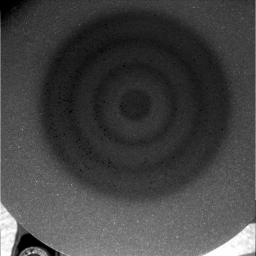
|
Mars Magnet Hits the Bull’s-Eye
- Click the image above for a larger view
- Full-Res JPEG (1024 x 1024) (168.7 kB)
- Full-Res TIFF (1024 x 1024) (1.0 MB)
Caption:
This image shows the Mars Exploration Rover Opportunity's "capture magnet," which attracts atmospheric dust particles from the front deck of the rover. The lighter-colored areas in the image are clean sections of the magnet virtually free of dust, and the dark areas are places where dust has collected. Scientists were surprised to see the black specks in the microscopic image, which are either unexpectedly large dust particles or collections of many particles bound together. Dust particles in the martian atmosphere are estimated to be about 1 micrometer in size (1/1000th of a millimeter (.04 inch)). The dark specks seen here are much larger than that. The whole image is 3 centimeters (1.2 inches) across.
The material below the magnet's aluminum surface is laid out in concentric rings, giving the image a bull's-eye appearance. The magnet was designed in this configuration to collect as much atmospheric dust as possible. If the magnet were one large cylinder, it would create the largest magnetic field, but not the most attractive magnetic force. In this bull's-eye layout, the force of the magnet lures the dust particles as they drift around the rovers, collecting the particles on the magnet surface for further study.
Spirit and Opportunity each carry seven magnets. Four magnets are inside the rovers' rock abrasion tools, and three others are at the back and front of the rovers. The magnets are five to 10 times stronger than a normal refrigerator magnet. They help scientists better understand how the airborne dust on Mars was formed and why it is so magnetic. Most scientists believe the martian dust has "global properties," meaning that its chemical composition is similar around the globe.
Because Opportunity landed on Mars roughly one month after Spirit, right now it has a thinner dust layer on top of its capture magnet. Scientists will wait until more dust collects on Opportunity's magnets before looking at the dust with the rover's alpha particle x-ray spectrometer and Moessbauer instruments. Spirit has already taken x-ray spectrometer readings of the dust collected on one of its magnets, and scientists are busy analyzing the data.
The science team will study the differences and similarities of the dust collected on Spirit and Opportunity, which are roving on opposite sides of the planet. The magnet images from this mission will also be compared to images from magnet tests on Earth.
This image was taken by Opportunity's microscopic imager on the 38th martian day, or sol, of the rover's mission.
Background Info:
More information about the rover magnets can be found at the University of Copenhagen's Center for Planetary Science web site at http://www.fys.ku.dk/mars/ .
Cataloging Keywords:
| Name | Value | Additional Values |
|---|---|---|
| Target | Mars | |
| System | ||
| Target Type | Planet | |
| Mission | Mars Exploration Rover (MER) | |
| Instrument Host | Opportunity (MER-B) | Spirit (MER-A) |
| Host Type | Rover | |
| Instrument | Microscopic Imager (MI) | |
| Detector | ||
| Extra Keywords | Atmosphere, Dust, Grayscale, Magnetosphere | |
| Acquisition Date | ||
| Release Date | 2004-03-04 | |
| Date in Caption | ||
| Image Credit | NASA/JPL | |
| Source | photojournal.jpl.nasa.gov/catalog/PIA05496 | |
| Identifier | PIA05496 | |
